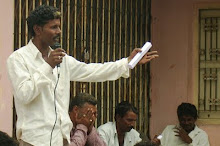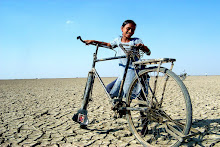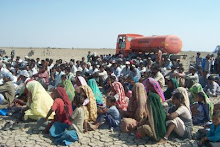Indian Express: Ahmedabad: Saturday, 25 May 2024.
Karim Manakh stacked up the salt on one side of his 10-acre pan and wound up his day on April 27. Later in the night, he stepped out of his makeshift hut near the salt pan to attend nature’s call when he found his legs in deep water. “I immediately asked my wife and my children to move to higher ground. But we could not stop the water from ruining our salt pans. Eventually, some of the workers among us deployed excavators to create bunds so that the flooding water could be stopped from further damaging the salt pans,” the 45-year-old says.
However, the water had already destroyed his toil for over six months. “My earnings for the entire monsoon have been washed away by the flooding water,” said a visibly upset Manakh.
A resident of Nava Anjiyasar village 2-3 kilometers away from the salt pans where he barely stays for a month, Manakh is into shrimp fishing when he is not farming salt.
Manakh was among the many salt cultivators from Gulabadi, Ankodiya and Haripar areas of Maliya taluka in Morbi who allegedly suffered losses after the irrigation department released waters from Machchhu III and Machchhu II flooding their pans on April 26 and May 12. The water was released after taking due permission for repairing the floodgates.
Rajkot irrigation circle’s Morbi division Executive Engineer Preksha Goswami said that five of the 20 floodgates installed in 1989 had weakened and needed to be replaced. These floodgates are 41 feet high and 27 feet wide each. Machchhu-II dam has 38 gates. Among them, 18 are in the old spillway and 20 are in the new spillway.
Before releasing the water, the authorities had issued alerts in April, which were marked to officials from the irrigation, revenue, roads and building, as well as police departments. The same were also marked to the Morbi district collectorate, chief officer of Maliya (Miyana) Nagarpalika and a voluntary group supporting small salt pan workers named Agariya Heet Rakshak Manch (AHRM). These were directed to ensure that residents did not venture into the riverbed during the release of water, for safety reasons.
At the time of the release, the reservoir level of Machchhu II dam was 53 metres against its full reservoir level (FRL) of 57.30 metres, while that of the Machchhu III dam was at FRL of 28.70 metres, a senior official from the state irrigation department said.
Notably, Machchhu II dam had breached in 1979, flooding the Morbi town and a few dozen villages downstream of Morbi and Maliya talukas.
Vishal Patel, deputy engineer in charge of Machchhu II, had earlier told The Indian Express that the water was meant to fill up 12 check dams downstream, besides village ponds, by channeling water in the irrigation canal of Machchhu III. However, a bund downstream of the river, appears to have blocked the water, causing it to overflow, AHRM president Harinesh Pandya told The Indian Express, estimating that around 120 farmers have been affected. “The authorities released more water than the carrying capacity of the riverbed… The bund was later removed by the authorities by JCB machines and hence, more flooding could be avoided. But the administration should have known about this bund before releasing water in such huge quantities,” he said.
Maliya mamlatdar, K V Saniya, said no flooding was reported on May 12 after the removal of the bund. “Some salt cultivators had created a bund on the riverbed for crossing. Hence, the flow got obstructed,” says Saniya, according to whose estimates, three-four salt pans near the riverbed were flooded on April 26.
Maliya, which is part of the Little Rann of Kutch, employs nearly 1,600 salt pan workers. Smaller, traditional cultivators work on 10-acre farms, while the commercial-sized farms range from 500 to 9,000 acres.
In a typical season, Manakh gets Rs 9,000 as monthly salary and 25 per cent of the cost of the cultivated salt from the primary cultivator for whom he works as a share-cropper.
Chothabhai Bhimani (58), a traditional salt cultivator who owns salt farms in Maliya, says, “I got a call from my workers at the salt pan about the flooding by Machchhu III waters on April 28 midnight. My entire plot got submerged. We had to employ four to five pumps to dewater our plot for which I spent around Rs 20,000 on the diesel.”
By May 12, when the Machchhu II gates were opened, a more vigilant Bhimani had hired excavators for Rs 1,400 an hour. “We had to spend around Rs 50,000 to stop the flooding water from further damaging our salt pans (as a precautionary measure). The loss of salt crop is in addition to that,” Bhimani says.
While environmentalists say the situation could have been avoided, had the authorities properly planned the water storage in the two dams and its release, various salt pan workers’ associations have written to the Morbi district collector demanding a survey of the damages and compensation.
Devabhai Ahir, president of Shree Maliya Miyana Taluka Ten Acre Mitha Utpadak Association, an association of small and traditional salt cultivators, said many small salt cultivators have lost their earnings for the entire season due to the flooding. “We are definitely going to survey. If the government scheme regarding (compensation under) disaster allows, then I will send a proposal to my immediate superior,” Morbi District Collector K B Jhaveri said.
Meanwhile, activists also allege that the precious Narmada water that had filled up the dam was wasted into the sea at peak summer. “When the dam was to be repaired, it should have been planned when there is minimum water in it. Machchhu dam does not have rain water; you fill it with Narmada water. So much water, ultimately, was released into the sea while washing away the salt pans,” AHRM state coordinator Pankti Jog said.
Environmentalist Rohit Prajapati says, “They (irrigation department) got feedback in December (about repairing the dam). They could have regulated the water in Machchhu dams from December onwards. They absolutely failed there. For salt pan workers, it was a flash flood… It was illogical to fill the dam (Machchhu II) up to 53 metre when it was to be repaired. That water should have been put to use; instead, it was wasted,” he said.
Machchhu-II dam is an important source of drinking water for Morbi and Jamnagar. Executive Engineer Goswami had earlier told this paper that drinking water supply would not be affected as the Sardar Sarovar Narmada Nigam Limited (SSNNL) would continue discharging 150 cusecs of water into Machchhu-II dam to meet drinking water requirement.
When asked about the salt pan workers’ complaint that they suffered losses due to the release of water from the two dams, Goswami said, “No such issue has come up.”
She added, “The water was released after informing them (salt cultivators). It is not that the water was released without informing them… I have to provide drinking water and water for irrigation as well. For this, I have to keep the dam filled up to its (reservoir) level. Also, the water we got from SSNNL in the dam has been lifted under SAUNI Yojana.”
Karim Manakh stacked up the salt on one side of his 10-acre pan and wound up his day on April 27. Later in the night, he stepped out of his makeshift hut near the salt pan to attend nature’s call when he found his legs in deep water. “I immediately asked my wife and my children to move to higher ground. But we could not stop the water from ruining our salt pans. Eventually, some of the workers among us deployed excavators to create bunds so that the flooding water could be stopped from further damaging the salt pans,” the 45-year-old says.
However, the water had already destroyed his toil for over six months. “My earnings for the entire monsoon have been washed away by the flooding water,” said a visibly upset Manakh.
A resident of Nava Anjiyasar village 2-3 kilometers away from the salt pans where he barely stays for a month, Manakh is into shrimp fishing when he is not farming salt.
Manakh was among the many salt cultivators from Gulabadi, Ankodiya and Haripar areas of Maliya taluka in Morbi who allegedly suffered losses after the irrigation department released waters from Machchhu III and Machchhu II flooding their pans on April 26 and May 12. The water was released after taking due permission for repairing the floodgates.
Rajkot irrigation circle’s Morbi division Executive Engineer Preksha Goswami said that five of the 20 floodgates installed in 1989 had weakened and needed to be replaced. These floodgates are 41 feet high and 27 feet wide each. Machchhu-II dam has 38 gates. Among them, 18 are in the old spillway and 20 are in the new spillway.
Before releasing the water, the authorities had issued alerts in April, which were marked to officials from the irrigation, revenue, roads and building, as well as police departments. The same were also marked to the Morbi district collectorate, chief officer of Maliya (Miyana) Nagarpalika and a voluntary group supporting small salt pan workers named Agariya Heet Rakshak Manch (AHRM). These were directed to ensure that residents did not venture into the riverbed during the release of water, for safety reasons.
At the time of the release, the reservoir level of Machchhu II dam was 53 metres against its full reservoir level (FRL) of 57.30 metres, while that of the Machchhu III dam was at FRL of 28.70 metres, a senior official from the state irrigation department said.
Notably, Machchhu II dam had breached in 1979, flooding the Morbi town and a few dozen villages downstream of Morbi and Maliya talukas.
Vishal Patel, deputy engineer in charge of Machchhu II, had earlier told The Indian Express that the water was meant to fill up 12 check dams downstream, besides village ponds, by channeling water in the irrigation canal of Machchhu III. However, a bund downstream of the river, appears to have blocked the water, causing it to overflow, AHRM president Harinesh Pandya told The Indian Express, estimating that around 120 farmers have been affected. “The authorities released more water than the carrying capacity of the riverbed… The bund was later removed by the authorities by JCB machines and hence, more flooding could be avoided. But the administration should have known about this bund before releasing water in such huge quantities,” he said.
Maliya mamlatdar, K V Saniya, said no flooding was reported on May 12 after the removal of the bund. “Some salt cultivators had created a bund on the riverbed for crossing. Hence, the flow got obstructed,” says Saniya, according to whose estimates, three-four salt pans near the riverbed were flooded on April 26.
Maliya, which is part of the Little Rann of Kutch, employs nearly 1,600 salt pan workers. Smaller, traditional cultivators work on 10-acre farms, while the commercial-sized farms range from 500 to 9,000 acres.
In a typical season, Manakh gets Rs 9,000 as monthly salary and 25 per cent of the cost of the cultivated salt from the primary cultivator for whom he works as a share-cropper.
Chothabhai Bhimani (58), a traditional salt cultivator who owns salt farms in Maliya, says, “I got a call from my workers at the salt pan about the flooding by Machchhu III waters on April 28 midnight. My entire plot got submerged. We had to employ four to five pumps to dewater our plot for which I spent around Rs 20,000 on the diesel.”
By May 12, when the Machchhu II gates were opened, a more vigilant Bhimani had hired excavators for Rs 1,400 an hour. “We had to spend around Rs 50,000 to stop the flooding water from further damaging our salt pans (as a precautionary measure). The loss of salt crop is in addition to that,” Bhimani says.
While environmentalists say the situation could have been avoided, had the authorities properly planned the water storage in the two dams and its release, various salt pan workers’ associations have written to the Morbi district collector demanding a survey of the damages and compensation.
Devabhai Ahir, president of Shree Maliya Miyana Taluka Ten Acre Mitha Utpadak Association, an association of small and traditional salt cultivators, said many small salt cultivators have lost their earnings for the entire season due to the flooding. “We are definitely going to survey. If the government scheme regarding (compensation under) disaster allows, then I will send a proposal to my immediate superior,” Morbi District Collector K B Jhaveri said.
Meanwhile, activists also allege that the precious Narmada water that had filled up the dam was wasted into the sea at peak summer. “When the dam was to be repaired, it should have been planned when there is minimum water in it. Machchhu dam does not have rain water; you fill it with Narmada water. So much water, ultimately, was released into the sea while washing away the salt pans,” AHRM state coordinator Pankti Jog said.
Environmentalist Rohit Prajapati says, “They (irrigation department) got feedback in December (about repairing the dam). They could have regulated the water in Machchhu dams from December onwards. They absolutely failed there. For salt pan workers, it was a flash flood… It was illogical to fill the dam (Machchhu II) up to 53 metre when it was to be repaired. That water should have been put to use; instead, it was wasted,” he said.
Machchhu-II dam is an important source of drinking water for Morbi and Jamnagar. Executive Engineer Goswami had earlier told this paper that drinking water supply would not be affected as the Sardar Sarovar Narmada Nigam Limited (SSNNL) would continue discharging 150 cusecs of water into Machchhu-II dam to meet drinking water requirement.
When asked about the salt pan workers’ complaint that they suffered losses due to the release of water from the two dams, Goswami said, “No such issue has come up.”
She added, “The water was released after informing them (salt cultivators). It is not that the water was released without informing them… I have to provide drinking water and water for irrigation as well. For this, I have to keep the dam filled up to its (reservoir) level. Also, the water we got from SSNNL in the dam has been lifted under SAUNI Yojana.”

















.jpg)
.jpg)
.jpg)
.jpg)













No comments:
Post a Comment